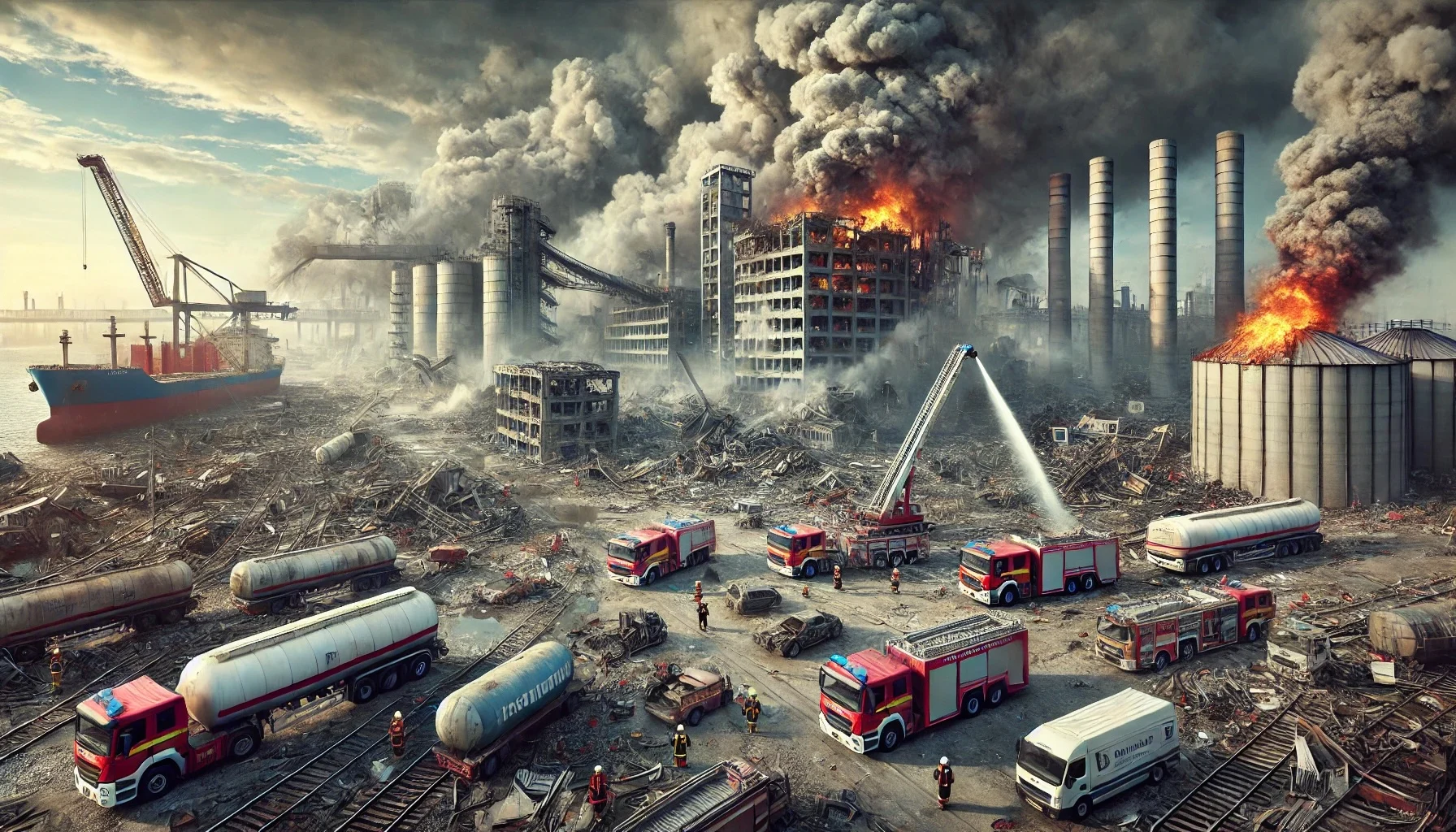
The 2015 Tianjin Explosions
by: The Calamity Calendar Team
August 12, 2015
In the heart of one of China’s largest port cities, the air was thick with the anticipation of another busy night at the Port of Tianjin. This industrial hub was a critical artery of China’s economic engine, bustling with activity as cargo moved in and out of the sprawling facilities. Yet, lurking in the shadows of its busy docks and warehouses was a danger few foresaw—a volatile cocktail of hazardous chemicals that would soon ignite into a disaster of unprecedented scale.
A City on Edge
Tianjin, with its vast chemical plants and warehouses, was always teetering on the edge of danger. Among these facilities was the Ruihai Logistics warehouse, a massive depot for hazardous chemicals, including thousands of tons of ammonium nitrate, a highly explosive substance. Despite its pivotal role in handling dangerous materials, the warehouse was a mere stone’s throw away from residential areas, a violation of safety regulations that required a minimum distance of 1,000 meters.
In the months leading up to the incident, concerns had been mounting over the potential dangers posed by the proximity of hazardous chemical storage to populated areas. Whispers of bribery and corruption circulated, alleging that Ruihai Logistics had greased the palms of regulatory bodies to bypass crucial safety protocols. These fears would prove tragically prophetic.
The Night of the Explosions
On the night of August 12, 2015, at precisely 10:50 PM, a fire broke out at the Ruihai Logistics warehouse. It began as a small blaze in a shipment of dry chemicals, but the flames quickly spiraled out of control, feeding off the highly combustible materials stored within the facility. As the fire intensified, firefighters rushed to the scene, battling the inferno with all the resources at their disposal.
Thanks for subscribing!
But at 11:34 PM, the unthinkable happened—the first major explosion tore through the night, its force equivalent to 2.9 tons of TNT. The blast shattered windows, toppled buildings, and sent shockwaves rippling across the city. Just thirty seconds later, a second, even more powerful explosion erupted, equivalent to 21 tons of TNT, leveling the surrounding area and turning night into day with its blinding light.
The Aftermath: Chaos and Destruction
The explosions triggered a series of smaller blasts, igniting fires that raged into the early hours of the morning. The seismic events were so powerful that they were detected by the China Earthquake Networks Center, illustrating the sheer force of the explosions.
As dawn broke, the true extent of the devastation became apparent. The human toll was staggering: 173 people lost their lives, including 104 brave firefighters who had rushed to confront the inferno. Among the dead were 11 police officers and 58 civilians, and over 800 more suffered injuries of varying degrees.
The physical damage was no less severe. An estimated 17,000 homes were damaged, and around 12,000 vehicles were incinerated. The port’s infrastructure lay in ruins, with the economic cost of the disaster reaching approximately $1.1 billion USD.
A Nation Responds
In the wake of the disaster, the Chinese government launched an extensive emergency response, deploying thousands of firefighters, police officers, and military personnel to manage the chaos and conduct search and rescue operations. Hospitals across Tianjin were overwhelmed with casualties, prompting the arrival of medical teams from all over the country.
However, the explosions’ impact extended beyond immediate human and material losses. The blasts released a toxic cocktail of chemicals into the environment, including sodium cyanide, sparking fears of widespread contamination and long-term health risks. Authorities embarked on a massive decontamination effort, monitoring air and water quality to safeguard public health and mitigate environmental impacts.
Unraveling the Causes: Corruption and Compliance
As investigators sifted through the rubble, a damning narrative of regulatory failure and corruption emerged. Several executives from Ruihai Logistics were arrested and prosecuted, their actions laying bare a culture of negligence and bribery that had allowed the warehouse to operate with impunity. Criminal charges were filed, leading to convictions that underscored the systemic issues within China’s industrial oversight.
The catastrophe forced the Chinese government to take a hard look at its regulatory framework, prompting a series of sweeping changes aimed at preventing future disasters. New laws and regulations were enacted to tighten control over the storage and handling of hazardous chemicals. Safety inspections became more rigorous, and chemical warehouses were relocated away from residential areas, a clear acknowledgment of the lapses that had led to the disaster.
A Legacy of Change
In the years since the Tianjin explosions, China has made significant strides in improving industrial safety standards. Enhanced inspection protocols, improved emergency response measures, and heightened public awareness of chemical safety have contributed to a safer industrial landscape. Ongoing environmental monitoring continues to ensure long-term recovery and address any residual contamination, with authorities committed to rehabilitating affected areas and supporting impacted communities.
Commemorating the Fallen
Each year, Tianjin commemorates the lives lost in the explosions, honoring the bravery of first responders and the resilience of the community. Memorial services serve as a solemn reminder of the human cost of industrial negligence, a tribute to those who perished and a pledge to uphold safety standards in their memory.
The Tianjin explosions stand as a stark warning of the potential consequences of regulatory complacency and corruption. The tragedy’s legacy endures as a catalyst for change, reinforcing the critical importance of industrial safety and accountability in protecting lives and communities.
Stay in the Loop!
Become a Calamity Insider and get exclusive Calamity Calendar updates delivered straight to your inbox.
Thanks! You're now subscribed.